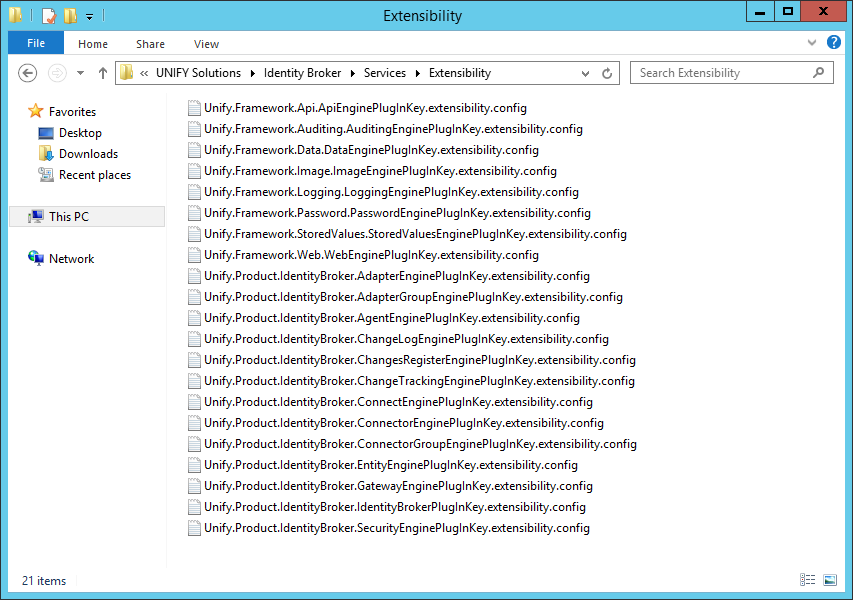Migrating UNIFYBroker Between Environments
Configuration Migration
UNIFYBroker uses a local storage mechanism for persisting its configuration. This is located in a series of XML files located in the Extensibility directory in the UNIFYBroker service directory.

Migrating between development, test, and production environments can be as simple as copying the contents of this directory into the Extensibility directory of the new environment while the UNIFYBroker service is turned off (not just the scheduler). When the UNIFYBroker service is restarted, the new configuration will be loaded. The breakdown of these files is as follows:
| Filename | Description |
|---|---|
| Unify.Framework.Api.ApiEnginePlugInKey.extensibility.config.xml | The configuration for all existing APIs. |
| Unify.Framework.Auditing.AuditingEnginePlugInKey.extensibility.config.xml | Contains default and additional auditing configuration. |
| Unify.Framework.Data.DataEnginePlugInKey.extensibility.config.xml | The connection details to the Identity Broker database. |
| Unify.Framework.Image.ImageEnginePlugInKey.extensibility.config.xml | A store for images used by Identity Broker plugins such as connectors and adapters. |
| Unify.Framework.Logging.LoggingEnginePlugInKey.extensibility.config.xml | Contains default and additional logging configuration. |
| Unify.Framework.Password.PasswordEnginePlugInKey.extensibility.config.xml | Settings for an engine that generates random passwords for other plugins, for example some connectors. |
| Unify.Framework.StoredValues.StoredValuesEnginePlugInKey.extensibility.config.xml | The database reference for the stored values engine. Some connectors use the stored values engine for saving state between operations. |
| Unify.Framework.Web.WebEnginePlugInKey.extensibility.config.xml | Used to configure the self-hosted option. |
| Unify.Product.IdentityBroker.AdapterEnginePlugInKey.extensibility.config.xml | The configuration for all existing Adapters. |
| Unify.Product.IdentityBroker.AdapterGroupEnginePlugInKey.extensibility.config.xml | The configuration for all existing Adapter Groups. |
| Unify.Product.IdentityBroker.AgentEnginePlugInKey.extensibility.config.xml | The configuration for all existing Agents. |
| Unify.Product.IdentityBroker.ChangeLogEnginePlugInKey.extensibility.config.xml | The database reference for the LDAP change log engine. |
| Unify.Product.IdentityBroker.ChangesRegisterEnginePlugInKey.extensibility.config.xml | The database reference for the Change Detection engine. |
| Unify.Product.IdentityBroker.ChangeTrackingEnginePlugInKey.extensibility.config.xml | The database reference for the Change Tracking engine. |
| Unify.Product.IdentityBroker.ConnectorEnginePlugInKey.extensibility.config.xml | The configuration for all existing Connectors. |
| Unify.Product.IdentityBroker.ConnectorGroupEnginePlugInKey.extensibility.config.xml | The configuration for all existing Connector Groups. |
| Unify.Product.IdentityBroker.EntityEnginePlugInKey.extensibility.config.xml | The database reference for the Entities engine. |
| Unify.Product.IdentityBroker.GatewayEnginePlugInKey.extensibility.config.xml | The configuration for all existing Gateways. |
| Unify.Product.IdentityBroker.SecurityEnginePlugInKey.extensibility.config.xml | The LDAP Security configuration. |
In addition to the above files, some environments may have also updated the following files:
Unify.Service.Connect.Debug.exe.configUnify.Service.Connect.exe.configUnify.Service.Connect32.Debug.exe.configUnify.Service.Connect32.exe.configWeb.config
If these files have been modified, they should also be migrated.
See Moving the Identity Broker database for information relating to the UNIFYBroker database.
Migration Considerations
There are a few issues to consider when migrating configuration between environments:
- Ensure that the database has been correctly migrated and that the Data Configuration is targeting the correct database.
- Partial migrations are possible using the table above, however, the absence of configured agents will result in incomplete connector configuration.
- Any partitions (e.g. Connector, Adapter, Locker, etc.) that are removed from configuration will result in the entities being removed from the UNIFYBroker database.
- Agent configuration is not updated when the configuration is migrated. This means that agents will still use the server names specified in the source environment. Consider the use of aliases to ensure configuration remains consistent.
- If aliases are not used, Agents will need to be reconfigured to point to the relevant servers in the new environment.
- Individual connectors need not be updated unless they reference items that are located in a different location to the base environment, such as PowerShell Connector.
- It is advisable to disable the UNIFYBroker scheduler before migrating configuration.
Customer support service by UserEcho

